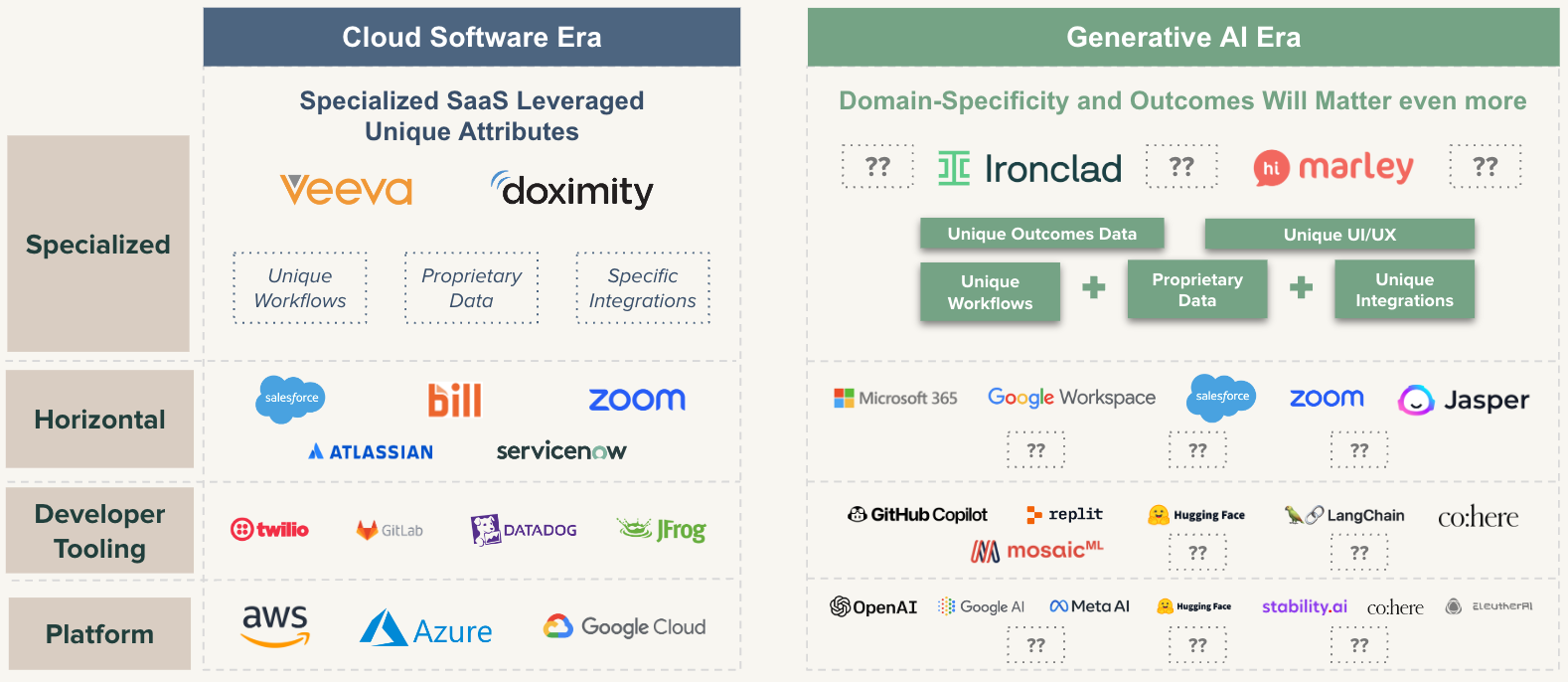Specialized Software Will Win in the Age of Generative AI
Lessons from Investor at the Center of 25 Years of Software Shifts
We’re at an inflection point. The buzz around generative AI has founders and investors scrambling to find promising applications for the technology. In Q1 of 2023 alone, $1.7 billion was invested in 46 generative AI companies. As startups continue to proliferate and money continues to flood the space, we want to take a broader look back at lessons learned from previous platform shifts.
For the past 20 years at Emergence, we’ve witnessed many trends and hype cycles that haven’t lasted, but also many that have. We see many similarities between the platform shifts of the past two decades and what we’re seeing unfold today with generative AI. From the advent of horizontal cloud software in the early-2000s to the promise of industry-specific cloud software in the late-2000s, one thing is evident: specialized software builds tremendous value.
During each platform shift, early companies started by building broad solutions, and only as the technology matured did companies start to build more specific software for industries or targeted jobs-to-be-done (JTBD). We think the same applies to today’s generative AI hype cycle. In this piece, I surface the throughlines between these platform shifts for founders to apply as they think about building in the context of generative AI.
On-premise to the cloud
Back in the early 2000s, the shift from on-premise to the cloud democratized software. For the first time ever, if you had a web browser, you could instantaneously use software to run a portion of your business or personal life—all from the cloud. I had the good fortune of working with Marc Benioff as he was launching Salesforce.com. I also co-founded a company with Marc called Software As Service, and it became the origin of the Salesforce Platform.
What Marc saw in the early days of Salesforce was the ability to bring Amazon-style value and simplicity to every business user because the browser allowed for easy adoption. Some of the fastest-growing companies of that era, including Salesforce, Workday, and ServiceNow, created cloud software that replaced the former broad client-server leaders. These early companies revolutionized software with a new model that has now become the software standard.
What was also unique about the cloud was that it disrupted long-standing distribution channels, such as value-added resellers (VARS) and distributors. Instead, these cloud software companies leveraged a product-led strategy that had a rapid impact on the market. On-premise players who couldn’t adapt fast enough eventually faded away, while startups (and a small number of incumbents) who adopted the cloud, prospered.
Eventually, further specialization within the horizontal cloud created dozens of more-targeted successes. Companies such as ZoomInfo, SalesLoft, and Chorus focused on building software for specific jobs within the sales stack, picking up where Salesforce left off. With products much more tailored to specific jobs-to-be-done, specialized players can better serve their users than broad horizontal providers.
Emergence of Industry Cloud
As cloud software became the norm, the second major platform shift we witnessed was the transition from horizontal to industry-specific cloud software. Again, I had the good fortune of working with the leader who created this shift, Peter Gassner of Veeva Systems. We coined this emerging field in 2008 as Industry Cloud, after leading the only institutional investment in Veeva (where I have been chairman since their IPO).

The Industry Cloud shift was where the power of data became really important. One key hallmark of an Industry Cloud company is “deep data.” This industry-specific model of building software has the ability to create customer value from user data—both through user entries and from behavioral analysis. While all cloud companies have this potential, a deep industry focus makes it far more likely for Industry Cloud companies to turn data into meaningful insights for their customers.
The emergence of this new type of software was so impactful because of its ability to focus both on the needs of a single industry, and on deep data that comes with “layering the cake” within that industry. Whereas horizontal cloud companies were broad-based across every industry, and therefore had less-actionable data, Industry Cloud companies “deepened” their datasets by stacking multiple functional areas within companies of a single industry. This is the root of deep data.
Veeva is a perfect example of this. By picking one industry (life sciences) and over time developing 30+ products to solve the industry’s specific challenges, Veeva was able to create tremendous value very quickly, and using far less capital than their horizontal cousins. They've reached well over $2B in revenue on only $3M invested. Mass customization by vertical or functional slice, with a purpose-built solution that meets your customer’s unique needs, has become the new key to success in the software industry. In other words, specialization works.
Get specific to build tremendous value
As we settle into the generative AI era, we believe that the key step for founders will be to apply the lessons learned from the platform shifts that came before. What began as broad, horizontal software narrowed and became specific, and later became industry-focused. In this next age of technology, specialized software and proprietary data are even more important than they were in the cloud era.
With the rise in popularity of AI, companies are now trying to answer any question a consumer could possibly ask. But in business settings, similar to all cloud software, AI’s value will be most powerful when tightly focused. This is because generic AI models were trained on large swaths of data instead of the narrow, specific use cases required to provide value to these B2B organizations.
Just as with Industry Cloud, the tighter the context around the problem a company is trying to solve, the more valuable these new AI systems will be.
Today’s startups face significant differences from those of previous eras
Today, generative AI applications are starting broad, just as early cloud companies did, but the key difference is that the underlying technology is closely aligned with Microsoft, Google, Meta, and others who are the largest players in tech. This is different from the cloud era in that Salesforce, Workday, ServiceNow, etc. were startups and built from the ground up. With big tech owning much of the broad horizontal applications, startups should focus on building in specific domains with narrow context. Further, with APIs and open-source models, generative AI tech is far easier for anyone—both incumbents and startups—to adopt.

Founders building in generative AI today can take many paths, but I see two ways forward to build a lasting, defensible business. First understand your and your team’s core strength, then, choose one of these options:
- Major in generative AI’s emerging technical capabilities and hunt for a function or vertical problem that benefits from your insights. Or…
- Major in deep domain expertise and market relationships, and form a team to add in the technical knowledge.
Given the broad accessibility of AI capabilities, both of these strategies can lead to large opportunities for startups.

In the age of generative AI, one lesson remains true: the tighter your context and industry, the wiser your model and product. At Emergence, we’ve been diving deep into how generative AI fits into the context of the broader cloud software landscape, which you can see below.

As a former founder and investor in cloud software for the past 20+ years, I’m confident that generative AI applications will be successful if founders can apply these learnings and stay focused. If you’re working on something in the space, please don’t hesitate to reach out to me at gordon@emcap.com.
Enjoying this article?
Sign up to gain access to our thought leadership and have future articles delivered directly to your email.
